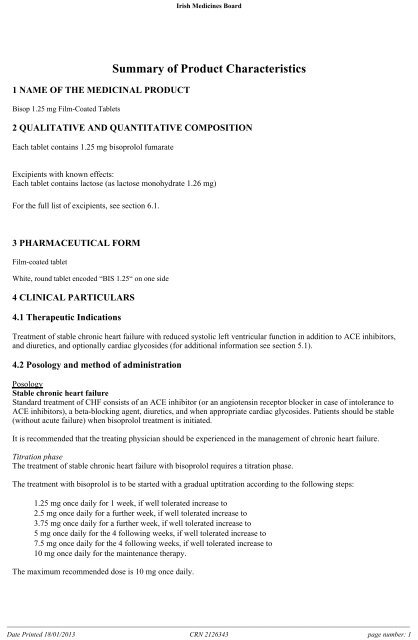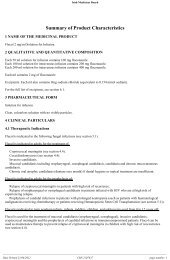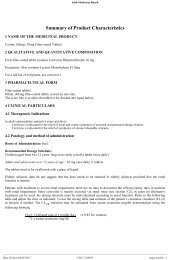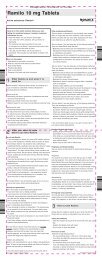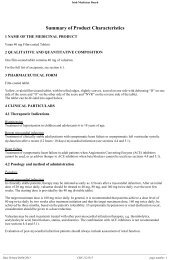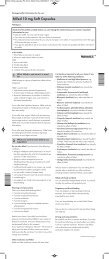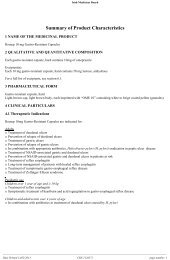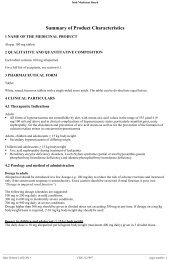Download Bisop 1.25mg SPC here - Rowex Ltd
Download Bisop 1.25mg SPC here - Rowex Ltd
Download Bisop 1.25mg SPC here - Rowex Ltd
You also want an ePaper? Increase the reach of your titles
YUMPU automatically turns print PDFs into web optimized ePapers that Google loves.
Irish Medicines Board1 NAME OF THE MEDICINAL PRODUCT<strong>Bisop</strong> 1.25 mg Film-Coated TabletsSummary of Product Characteristics2 QUALITATIVE AND QUANTITATIVE COMPOSITIONEach tablet contains 1.25 mg bisoprolol fumarateExcipients with known effects:Each tablet contains lactose (as lactose monohydrate 1.26 mg)For the full list of excipients, see section 6.1.3 PHARMACEUTICAL FORMFilm-coated tabletWhite, round tablet encoded “BIS 1.25“ on one side4 CLINICAL PARTICULARS4.1 Therapeutic IndicationsTreatment of stable chronic heart failure with reduced systolic left ventricular function in addition to ACE inhibitors,and diuretics, and optionally cardiac glycosides (for additional information see section 5.1).4.2 Posology and method of administrationPosologyStable chronic heart failureStandard treatment of CHF consists of an ACE inhibitor (or an angiotensin receptor blocker in case of intolerance toACE inhibitors), a beta-blocking agent, diuretics, and when appropriate cardiac glycosides. Patients should be stable(without acute failure) when bisoprolol treatment is initiated.It is recommended that the treating physician should be experienced in the management of chronic heart failure.Titration phaseThe treatment of stable chronic heart failure with bisoprolol requires a titration phase.The treatment with bisoprolol is to be started with a gradual uptitration according to the following steps:• 1.25 mg once daily for 1 week, if well tolerated increase to• 2.5 mg once daily for a further week, if well tolerated increase to• 3.75 mg once daily for a further week, if well tolerated increase to• 5 mg once daily for the 4 following weeks, if well tolerated increase to• 7.5 mg once daily for the 4 following weeks, if well tolerated increase to• 10 mg once daily for the maintenance therapy.The maximum recommended dose is 10 mg once daily.______________________________________________________________________________________________________________________Date Printed 18/01/2013 CRN 2126343 page number: 1
Irish Medicines BoardTransient worsening of heart failure, hypotension, or bradycardia may occur during the titration period and t<strong>here</strong>after.Close monitoring of vital signs (heart rate, blood pressure) and symptoms of worsening heart failure is recommendedduring the titration phase. Symptoms may already occur within the first day after initiating the therapy.Treatment modificationIf the maximum recommended dose is not well tolerated, gradual dose reduction may be considered.In case of transient worsening of heart failure, hypotension, or bradycardia reconsideration of the dosage of theconcomitant medication is recommended. It may also be necessary to temporarily lower the dose of bisoprolol or toconsider discontinuation.The reintroduction and/or uptitration of bisoprolol should always be considered when the patient becomes stable again.Duration of treatmentTreatment of stable chronic heart failure with bisoprolol is generally a long-term treatment.The treatment with bisoprolol must not be stopped abruptly since this might lead to a transitory worsening of condition.Especially in patients with ischaemic heart disease, treatment must not be discontinued suddenly. Gradual reduction ofthe daily dose is recommended.Renal or liver impairmentT<strong>here</strong> is no information regarding pharmacokinetics of bisoprolol in patients with chronic heart failure and withimpaired liver or renal function. Uptitration of the dose in these populations should t<strong>here</strong>fore be made with additionalcaution.ElderlyNo dosage adjustment is required.Paediatric populationT<strong>here</strong> is no experience with bisoprolol in children and adolescents, t<strong>here</strong>fore its use cannot be recommended forchildren.Method of administrationFor oral administration.<strong>Bisop</strong>rolol tablets should be taken in the morning and can be taken with food. They should be swallowed with liquidand should not be chewed.4.3 Contraindications<strong>Bisop</strong>rolol is contraindicated in:• acute heart failure or during episodes of heart failure decompensation requiring i.v. inotropic therapy• cardiogenic shock• AV block of second or third degree• sick sinus syndrome• sinoatrial block• symptomatic bradycardia• symptomatic hypotension• severe bronchial asthma or severe chronic obstructive pulmonary disease• severe forms of peripheral arterial occlusive disease or severe forms of Raynaud's syndrome• untreated phaeochromocytoma (see section 4.4)• metabolic acidosis• hypersensitivity to the active substance or to any of the excipients listed in section 6.1.4.4 Special warnings and precautions for use______________________________________________________________________________________________________________________Date Printed 18/01/2013 CRN 2126343 page number: 2
Irish Medicines BoardThe treatment of stable chronic heart failure with bisoprolol has to be initiated with a special titration phase (see section4.2).Especially in patients with ischaemic heart disease the cessation of therapy with bisoprolol must not be done abruptlyunless clearly indicated, because this may lead to transitional worsening of heart condition (see section 4.2).The initiation and cessation of treatment of stable chronic heart failure with bisoprolol necessitates regular monitoring.For the posology and method of administration please refer to section 4.2.<strong>Bisop</strong>rolol must be used with caution in:• bronchospasm (bronchial asthma, obstructive airways diseases).In bronchial asthma or other chronic obstructive lung diseases, which may cause symptoms, bronchodilatingtherapy should be given concomitantly. Occasionally an increase of the airway resistance may occur in patientswith asthma, t<strong>here</strong>fore the dose of beta2-stimulants may have to be increased.• diabetes mellitus with large fluctuations in blood glucose values. Symptoms of hypoglycaemia (e.g. tachycardia,palpitations or sweating) can be masked.• strict fasting.• ongoing desensitisation therapy. As with other beta-blockers, bisoprolol may increase both the sensitivitytowards allergens and the severity of anaphylactic reactions. Epinephrine treatment may not always yield theexpected therapeutic effect.• AV block of first degree.• Prinzmetal’s angina.• peripheral arterial occlusive disease. Aggravation of symptoms may occur especially when starting therapy.• General anaesthesia.In patients undergoing general anaesthesia beta-blockade reduces the incidence of arrhythmias and myocardialischaemia during induction and intubation, and the post-operative period. It is currently recommended thatmaintenance of beta-blockade should be continued peri-operatively. The anaesthetist must be aware of betablockadebecause of the potential for interactions with other medicinal products, resulting in bradyarrhythmias,attenuation of the reflex tachycardia and the decreased reflex ability to compensate for blood loss. If it is thoughtnecessary to withdraw beta-blocking agent therapy before surgery, this should be done gradually and completedabout 48 hours before anaesthesia.Patients with psoriasis or a history of psoriasis should only be given beta-blocking agents (e.g. bisoprolol) aftercarefully balancing the benefits against the risks.In patients with phaeochromocytoma bisoprolol must not be administered until after alpha-receptor blockade.Under treatment with bisoprolol the symptoms of a thyrotoxicosis may be masked.T<strong>here</strong> is no therapeutic experience of bisoprolol treatment of heart failure in patients with the following diseases andconditions:• insulin dependent diabetes mellitus (type I)• severely impaired renal function• severely impaired liver function• restrictive cardiomyopathy• congenital heart disease• haemodynamically significant organic valvular disease• myocardial infarction within 3 monthsLactoseThis medicinal product contains lactose. Patients with rare <strong>here</strong>ditary problems of galactose intolerance, the Lapplactase deficiency or glucose-galactose malabsorption should not take this medicine.4.5 Interaction with other medicinal products and other forms of interaction______________________________________________________________________________________________________________________Date Printed 18/01/2013 CRN 2126343 page number: 3
Irish Medicines BoardCombinations not recommendedCalcium antagonists of the verapamil type and to a lesser extent of the diltiazem type: Negative influence oncontractility and atrio-ventricular conduction. Intravenous administration of verapamil in patients on β-blockertreatment may lead to profound hypotension and atrioventricular block.Class I antiarrhythmic medicinal products (e.g. quinidine, disopyramide; lidocaine, phenytoin; flecainide,propafenone): Effect on atrio-ventricular conduction time may be potentiated and negative inotropic effect increased.Centrally-acting antihypertensive medicinal products such as clonidine and others (e.g. methyldopa, moxonodine,rilmenidine): Concomitant use of centrally-acting antihypertensive medicinal products may worsen heart failure by adecrease in the central sympathetic tonus (reduction of heart rate and cardiac output, vasodilation). Abrupt withdrawal,particularly if prior to beta-blocking agent discontinuation, may increase the risk of “rebound hypertension”.Combinations to be used with cautionCalcium antagonists of the dihydropyridine type such as felodipine and amlodipine: Concomitant use may increase therisk of hypotension, and an increase in the risk of a further deterioration of the ventricular pump function in patientswith heart failure cannot be excluded.Class-III antiarrhythmic medicinal product (e.g. amiodarone): Effect on atrio-ventricular conduction time may bepotentiated.Topical beta-blocking agents (e.g. eye drops for glaucoma treatment) may add to the systemic effects of bisoprolol.Parasympathomimetic medicinal products: Concomitant use may increase atrio-ventricular conduction time and the riskof bradycardia.Insulin and oral antidiabetic medicinal products: Increase of blood sugar lowering effect. Blockade of betaadrenoceptorsmay mask symptoms of hypoglycaemia.Anaesthetic agents: Attenuation of the reflex tachycardia and increase of the risk of hypotension (for furtherinformation on general anaesthesia see also section 4.4.).Digitalis glycosides: Reduction of heart rate, increase of atrio-ventricular conduction time.Non-steroidal anti-inflammatory drugs (NSAIDs): NSAIDs may reduce the hypotensive effect of bisoprolol.β-sympathomimetic agents (e.g. isoprenaline, dobutamine): Combination with bisoprolol may reduce the effect of bothagents.Sympathomimetics that activate both β- and α-adrenoceptors (e.g. noradrenaline, adrenaline): Combination withbisoprolol may unmask the α-adrenoceptor-mediated vasoconstrictor effects of these agents leading to blood pressureincrease and exacerbated intermittent claudication. Such interactions are considered to be more likely with nonselectiveβ-blockers.Concomitant use with antihypertensive agents as well as with other medicinal products with blood pressure loweringpotential (e.g. tricyclic antidepressants, barbiturates, phenothiazines) may increase the risk of hypotension.Combinations to be consideredMefloquine: increased risk of bradycardiaMonoamine oxidase inhibitors (except MAO-B inhibitors): Enhanced hypotensive effect of the beta-blocking agents,but also risk for hypertensive crisis.Rifampicin: Slight reduction of the half-life of bisoprolol possible due to the induction of hepatic drug-metabolisingenzymes. Normally no dosage adjustment is necessary.______________________________________________________________________________________________________________________Date Printed 18/01/2013 CRN 2126343 page number: 4
Irish Medicines BoardErgotamine derivatives: Exacerbation of peripheral circulatory disturbances.4.6 Fertility, pregnancy and lactationPregnancy<strong>Bisop</strong>rolol has pharmacological effects that may cause harmful effects on pregnancy and/or the foetus/newborn. Ingeneral, beta-adrenoceptor blocking agents reduce placental perfusion, which has been associated with growthretardation, intrauterine death, abortion or early labour. Adverse effects (e.g. hypoglycaemia and bradycardia) mayoccur in the foetus and newborn infant. If treatment with beta-adrenoceptor blocking agents is necessary, beta 1-selective adrenoceptor blocking agents are preferable.<strong>Bisop</strong>rolol is not recommended during pregnancy unless clearly necessary. If treatment with bisoprolol is considerednecessary, monitoring of the uteroplacental blood flow and the foetal growth is recommended. In case of harmfuleffects on pregnancy or the foetus consideration of alternative treatment is recommended. The newborn infant must beclosely monitored. Symptoms of hypoglycaemia and bradycardia are generally to be expected within the first 3 days.BreastfeedingT<strong>here</strong> are no data on the excretion of bisoprolol in human breast milk or the safety ot bisoprolol exposure in infants.T<strong>here</strong>fore, breastfeeding is not recommended during administration of bisoprolol.4.7 Effects on ability to drive and use machinesNo studies on the effects on the ability to drive and use machines have been performed. In a study with coronary heartdisease patients bisoprolol did not impair driving performance. Depending on the individual patient’s response theability to drive a vehicle or to use machines may be impaired. This needs to be considered particularly at start oftreatment, upon change of medication, or in conjunction with alcohol.4.8 Undesirable effectsThe following definitions apply to the frequency terminology used <strong>here</strong>after:Very common (≥ 1/10), Common (≥ 1/100 to < 1/10), Uncommon (≥ 1/1,000 to < 1/100), Rare (≥ 1/10,000 to< 1/1,000), Very rare (< 1/10,000), Not known (cannot be estimated from the available data).Psychiatric disordersUncommon: sleep disorders, depressionRare: nightmares, hallucinationsNervous system disordersCommon: dizziness, headacheRare: syncopeEye disordersRare: reduced tear flow (to be considered if the patient uses lenses)Very rare: conjunctivitisEar and labyrinth disordersRare: hearing disordersCardiac disordersVery rare: chest painVery common: bradycardia in patients with chronic heart failureCommon: worsening of pre-existing heart failure in patients with chronic heart failureUncommon: AV-conduction disturbancesVascular disorders______________________________________________________________________________________________________________________Date Printed 18/01/2013 CRN 2126343 page number: 5
Irish Medicines BoardCommon: feeling of coldness or numbness in the extremities, hypotension (especially in patients with heart failure)Uncommon: Orthostatic hypotensionRespiratory, thoracic and mediastinal disordersUncommon: bronchospasm in patients with bronchial asthma or a history of obstructive airways diseaseRare: allergic rhinitisGastrointestinal disordersCommon: gastrointestinal complaints such as nausea, vomiting, diarrhoea, constipationHepatobiliary disordersRare: hepatitisSkin and subcutaneous tissue disordersRare: hypersensitivity reactions (itching, flush, rash)Very rare: beta-blocking agents may provoke or worsen psoriasis or induce psoriasis-like rash, alopeciaMusculoskeletal and connective tissue disordersUncommon: muscular weakness, muscle crampsReproductive system and breast disordersRare: potency disordersGeneral disordersCommon: asthenia, fatigueInvestigationsRare: increased triglycerides, increased liver enzymes (ALAT, ASAT)4.9 OverdoseWith overdose (e.g. daily dose of 15 mg instead of 7.5 mg) third degree AV-block, bradycardia, and dizziness havebeen reported. In general, the most common signs expected with overdose of a beta-blocking agent are bradycardia,hypotension, bronchospasm, acute cardiac insufficiency and hypoglycaemia. To date a few cases of overdose(maximum: 2000 mg) with bisoprolol have been reported in patients suffering from hypertension and/or coronary heartdisease showing bradycardia and/or hypotension; all patients recovered. T<strong>here</strong> is a wide inter-individual variation insensitivity to one single high dose of bisoprolol and patients with heart failure are probably very sensitive. T<strong>here</strong>fore itis mandatory to initiate the treatment of these patients with a gradual uptitration according to the scheme given insection 4.2.In general, if overdose occurs, bisoprolol treatment should be stopped and supportive and symptomatic treatmentshould be provided. Limited data suggest that bisoprolol is hardly dialysable. Based on the expected pharmacologicactions and recommendations for other beta-blocking agents, the following general measures should be consideredwhen clinically warranted.Bradycardia: Administer intravenous atropine. If the response is inadequate, isoprenaline or another agent with positivechronotropic properties may be given cautiously. Under some circumstances, transvenous pacemaker insertion may benecessary.Hypotension: Intravenous fluids and vasopressors should be administered. Intravenous glucagon may be useful.AV block (second or third degree): Patients should be carefully monitored and treated with isoprenaline infusion ortransvenous cardiac pacemaker insertion.Acute worsening of heart failure: Administer i.v. diuretics, inotropic agents, vasodilating agents.Bronchospasm: Administer bronchodilator therapy such as isoprenaline, beta 2-sympathomimetic medicinal products______________________________________________________________________________________________________________________Date Printed 18/01/2013 CRN 2126343 page number: 6
Irish Medicines Boardand/or aminophylline.Hypoglycaemia: Administer i.v. glucose.5 PHARMACOLOGICAL PROPERTIES5.1 Pharmacodynamic propertiesPharmacotherapeutic group: Beta blocking agents, selective. ATC Code: C07AB07Mechanism of action<strong>Bisop</strong>rolol is a highly beta 1-selective-adrenoceptor blocking agent, lacking intrinsic sympathomimetic and relevantmembrane stabilising activity. It only shows low affinity to the beta 2-receptor of the smooth muscles of bronchi andvessels as well as to the beta 2-receptors concerned with metabolic regulation. T<strong>here</strong>fore, bisoprolol is generally not tobe expected to influence the airway resistance and beta 2-mediated metabolic effects. Its beta 1-selectivity extendsbeyond the therapeutic dose range.<strong>Bisop</strong>rolol is used for the treatment of hypertension, angina pectoris and heart failure. As with other beta-1-blockingagents, the method of acting in hypertension is unclear. However, it is known that bisoprolol reduces plasma reninactivity markedly.Antianginal mechanism: <strong>Bisop</strong>rolol by inhibiting the cardiac beta receptors inhibits the response given to sympatheticactivation. That results in the decrease of heart rate and contractility this way decreasing the oxygen demand of thecardiac muscle.The indication heart failure was investigated in the CIBIS II trial. In total 2647 patients were included, 83% (N = 2202)were in NYHA class III and 17% (N = 445) were in NYHA class IV. They had stable symptomatic systolic heartfailure (ejection fraction
Irish Medicines BoardAbsorption and distribution<strong>Bisop</strong>rolol is absorbed and has a biological availability of about 90% after oral administration. The plasma proteinbinding of bisoprolol is about 30%. The distribution volume is 3.5 l/kg.Biotransformation and eliminationTotal clearance is approximately 15 l/h. The half-life in plasma of 10-12 hours gives a 24 hour effect after dosing oncedaily.<strong>Bisop</strong>rolol is excreted from the body by two routes. 50% is metabolised by the liver to inactive metabolites which arethen excreted by the kidneys. The remaining 50% is excreted by the kidneys in an unmetabolised form. Since theelimination takes place in the kidneys and the liver to the same extent a dosage adjustment is not required for patientswith impaired liver function or renal insufficiency. The pharmacokinetics in patients with stable chronic heart failureand with impaired liver or renal function have not been studied.Linearity/non-linearityThe kinetics of bisoprolol are linear and independent of age.In patients with chronic heart failure (NYHA stage III) the plasma levels of bisoprolol are higher and the half-life isprolonged compared to healthy volunteers. Maximum plasma concentration at steady state is 64+21 ng/ml at a dailydose of 10 mg and the half-life is 17+5 hours.5.3 Preclinical safety dataPreclinical data reveal no special hazard for humans based on conventional studies of safety pharmacology, repeateddose toxicity, genotoxicity or carcinogenicity. Like other beta-blocking agents, bisoprolol caused maternal (decreasedfood intake and decreased body weight) and embryo/foetal toxicity (increased incidence of resorptions, reduced birthweight of the offspring, retarded physical development) at high doses, but was not teratogenic.6 PHARMACEUTICAL PARTICULARS6.1 List of excipientscalcium hydrogen phosphate, anhydrouscellulose, microcrystallinemaize starch, pregelatinisedcroscarmellose sodiumsilica, colloidal anhydrousmagnesium stearatelactose monohydratehypromellosemacrogol 4000titanium dioxide (E171)6.2 IncompatibilitiesNot applicable.6.3 Shelf lifeBlister: 60 months6.4 Special precautions for storageBlister: This medicinal product does not require any special storage conditions.6.5 Nature and contents of container______________________________________________________________________________________________________________________Date Printed 18/01/2013 CRN 2126343 page number: 8
Irish Medicines BoardThe container is a blister, which is made of an aluminium bottom and cover foil (OPA-Al-PVC/Al).Pack sizes Blister: 7, 10, 20, 28, 30, 50, 60, 100, 10x20, 10x30 film-coated tabletsNot all pack sizes may be marketed.6.6 Special precautions for disposal and other handlingNo special requirements.Any unused product or waste material should be disposed of in accordance with local requirements.7 MARKETING AUTHORISATION HOLDER<strong>Rowex</strong> <strong>Ltd</strong>BantryCo. CorkIreland8 MARKETING AUTHORISATION NUMBERPA711/159/19 DATE OF FIRST AUTHORISATION/RENEWAL OF THE AUTHORISATIONDate of first authorisation: 8 th December 2008Date of last renewal: 30 th May 201110 DATE OF REVISION OF THE TEXTDecember 2012______________________________________________________________________________________________________________________Date Printed 18/01/2013 CRN 2126343 page number: 9


